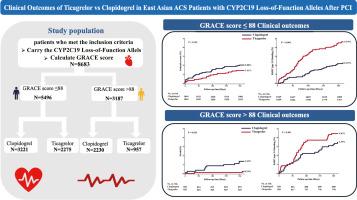Efficacy and safety of clopidogrel and ticagrelor in acute coronary syndrome patients with CYP2C19 loss-of-function alleles after percutaneous coronary intervention: based on the Global Registry of Acute Coronary Events score
IF 3.4
3区 医学
Q2 HEMATOLOGY
Research and Practice in Thrombosis and Haemostasis
Pub Date : 2025-08-01
DOI:10.1016/j.rpth.2025.102997
引用次数: 0
Abstract
Background
The selection of P2Y12 inhibitors for acute coronary syndrome patients after percutaneous coronary intervention (PCI) remains controversial among East Asian patients.
Objectives
This study aimed to identify the optimal P2Y12 inhibitor selection for the East Asian population carrying CYP2C19 loss-of-function (LOF) alleles based on the Global Registry of Acute Coronary Events (GRACE) score.
Methods
Between March 2016 and March 2019, a cohort of 8683 patients diagnosed with acute coronary syndrome who survived PCI were enrolled in this study. All patients carried the LOF allele and could calculate GRACE scores. The primary outcome was ischemic events (cardiac death, nonfatal myocardial infarction, and ischemic stroke) within 12 months. Secondary outcomes included the components of the primary outcome, all-cause mortality, Bleeding Academic Research Consortium (BARC) types 2, 3, and 5 bleeding events, and BARC types 3 and 5 bleeding events. The propensity score matching method was used to balance the baseline characteristics of patients. The Kaplan–Meier/log-rank test was adopted for the result analysis, and Cox regression was employed for adjusting for confounding factors.
Results
The low-risk group comprised 5496 patients (63.3%), while the intermediate- to high-risk group included 3187 patients (36.7%) in the study population stratified by GRACE scores. The follow-up results revealed that in patients at low risk, clopidogrel and ticagrelor had comparable effects in preventing ischemic events. However, ticagrelor use was associated with a higher risk of BARC types 2, 3, and 5 bleeding events (hazard ratio [HR], 2.08; 95% CI, 1.43-3.02; P < .001) and BARC types 3 and 5 bleeding events (HR, 2.69; 95% CI, 1.57-4.63; P < .001) compared with clopidogrel use. In patients at intermediate to high risk, ticagrelor treatment was associated with a lower risk of stroke (HR, 0.18; 95% CI, 0.04-0.82; P = .026), while the risk of ischemic events or bleeding was comparable between the 2 treatment groups.
Conclusion
These real-world data on East Asian patients with CYP2C19 LOF alleles suggest that GRACE risk stratification may help differentiate ischemic and bleeding risks post-PCI.

氯吡格雷和替格瑞洛在经皮冠状动脉介入治疗后伴有CYP2C19功能缺失等位基因的急性冠状动脉综合征患者中的疗效和安全性:基于急性冠状动脉事件全球登记评分
背景:急性冠状动脉综合征患者经皮冠状动脉介入治疗(PCI)后P2Y12抑制剂的选择在东亚患者中仍存在争议。本研究旨在根据全球急性冠状动脉事件登记(GRACE)评分,确定东亚人群携带CYP2C19功能丧失(LOF)等位基因的最佳P2Y12抑制剂选择。方法在2016年3月至2019年3月期间,8683名诊断为急性冠状动脉综合征并在PCI手术中存活的患者被纳入该研究。所有患者均携带LOF等位基因,可计算GRACE评分。主要终点是12个月内的缺血性事件(心源性死亡、非致死性心肌梗死和缺血性卒中)。次要结局包括主要结局、全因死亡率、出血学术研究联盟(BARC) 2型、3型和5型出血事件以及BARC 3型和5型出血事件。采用倾向评分匹配法平衡患者的基线特征。结果分析采用Kaplan-Meier /log-rank检验,混杂因素校正采用Cox回归。结果低危组5496例(63.3%),中危组3187例(36.7%)。随访结果显示,在低风险患者中,氯吡格雷和替格瑞洛在预防缺血性事件方面具有相当的效果。然而,与使用氯吡格雷相比,替格瑞洛与BARC 2型、3型和5型出血事件(风险比[HR], 2.08; 95% CI, 1.43-3.02; P < 0.001)和BARC 3型和5型出血事件(风险比[HR], 2.69; 95% CI, 1.57-4.63; P < 0.001)的风险较高。在中高风险患者中,替格瑞洛治疗与较低的卒中风险相关(HR, 0.18; 95% CI, 0.04-0.82; P = 0.026),而两个治疗组之间缺血性事件或出血的风险相当。结论:这些东亚患者CYP2C19 LOF等位基因的真实数据表明,GRACE风险分层可能有助于区分pci后的缺血和出血风险。
本文章由计算机程序翻译,如有差异,请以英文原文为准。
求助全文
约1分钟内获得全文
求助全文
来源期刊

Research and Practice in Thrombosis and Haemostasis
Medicine-Hematology
CiteScore
5.60
自引率
13.00%
发文量
212
审稿时长
7 weeks
 求助内容:
求助内容: 应助结果提醒方式:
应助结果提醒方式:


